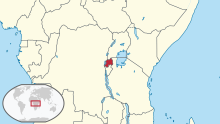Nymphaea thermarum
| Nymphaea thermarum | |
|---|---|

| |

| |
| Scientific classification | |
| Kingdom: | Plantae |
| Clade: | Tracheophytes |
| Clade: | Angiosperms |
| Order: | Nymphaeales |
| Family: | Nymphaeaceae |
| Genus: | Nymphaea |
| Subgenus: | Nymphaea subg. Brachyceras |
| Species: | N. thermarum
|
| Binomial name | |
| Nymphaea thermarum | |

| |
| Nymphaea thermarum is endemic to Rwanda[2][1] | |
Nymphaea thermarum is a species of water lily that is endemic to Rwanda. Once thought to be extinct in the wild, all wild plants were believed to be lost due to destruction of its native habitat, but it was thought to be saved from extinction when it was grown from seed at the Royal Botanic Gardens, Kew in 2009.[3][4] A previously-unknown wild population was discovered in 2023.[5]
Taxonomy
Nymphaea thermarum was discovered in 1987 by German botanist Eberhard Fischer. The specific epithet, thermarum, refers to the hot spring and temperature that provided its native habitat. There are no common names for the plant, though Kew Gardens is informally calling it "pygmy Rwandan water lily".[6][7]
Within the genus Nymphaea it is placed within Nymphaea subgen. Brachyceras.[8][9]
Cytology
The diploid chromosome count is 2n = 28. The genome size is 498.78 Mb.[8]
Description
This is the world's smallest water lily species; the pads (leaves) of N. thermarum can measure only 1 cm (0.39 in) across, less than 10% the width of the next smallest species in the genus Nymphaea (though they are more usually about 2 cm (0.79 in) or 3 cm (1.2 in)). By comparison, the largest water lily, Victoria amazonica, has pads that can reach 3 m (9.8 ft). Nymphaea thermarum forms rosettes 20 to 30 cm (7.9 to 11.8 in) wide, with bright green lily pads growing on short petioles. The very small flowers are white with yellow stamens, with the flowers held upright a few cm above the plant.
Breeding
They can self-pollinate, and after blooming the flower stalk bends so the fruit contacts the mud.
Conservation
The plant's native habitat was damp mud formed by the overflow of a freshwater hot spring in Mashyuza, southwest
The first published occurrence of N. thermarum germination was by Carlos Magdalena, at the Royal Botanical Gardens, Kew.[4] By placing the seeds and seedlings into pots of loam surrounded by water of the same level in a 25 °C (77 °F) environment, eight began to flourish and mature within weeks and in November 2009, the waterlilies flowered for the first time.[15] During this time, a rat had eaten one of the last two cultivated plants in Germany. With the germination problem solved, Magdalena says that the tiny plants are easy to grow, giving it potential to be grown as a houseplant.[16] In January 2014, a surviving water lily was stolen from the Royal Botanic Gardens.[17]
Uses
It has been proposed to be used as a model species for basal angiosperms, due to its small size, rapid lifecycle, and small genome.[11]
References
- ^ .
- ^ "Nymphaea thermarum Eb.Fisch". Plants of the World Online. Royal Botanic Gardens, Kew. Retrieved 30 June 2023.
- ^ Ghosh, Pallab (2010-05-18). "Waterlily saved from extinction". BBC News. Retrieved 19 May 2010.
- ^ a b c Magdalena, Carlos (November 2009). "The world's tiniest waterlily doesn't grow in water!". Water Gardeners International. 4 (4). Retrieved 2010-05-19.
- ^ Rwanda, National Herbarium of. "International Team of Botanists Rediscover Extinct Water Lily in Rwanda". PRLog. Retrieved 2023-10-19.
- ^ a b c Magdalena, Carlos. "Nymphaea thermarum". Plants & Fungi. Kew Gardens. Archived from the original on 23 May 2010. Retrieved 19 May 2010.
- ^ Fischer, Eberhard (1993). "Taxonomic results of the BRYOTROP-Expedition to Zaire and Rwanda" (PDF). Tropical Bryology. 8: 13–37. Archived from the original (PDF) on 2012-03-06. Retrieved 2010-05-19.
- ^ a b Chen, F., Liu, X., Yu, C., Chen, Y., Tang, H., & Zhang, L. (2017). "Water lilies as emerging models for Darwin’s abominable mystery." Horticulture research, 4.
- ^ Lei, M., & Hu, Y. (2022). "The complete chloroplast genome of Nymphaea thermarum (Nymphaeaceae) from Rwanda, Africa." Mitochondrial DNA Part B, 7(1), 289-291.
- ^ "In Harvard studies of plant tug-of-war, mom wins". Harvard Gazette. 2018-03-14. Retrieved 2023-10-19.
- ^ PMID 25497514.
- ISBN 978-1-4081-8632-9.
- ^ "Smallest waterlily in the world saved from extinction – by Kew Gardens". the Guardian. 2010-05-19. Retrieved 2021-11-15.
- ^ McCarthy, Michael (2010-05-19). "Smallest lily saved from extinction". The Independent. London. Retrieved 19 May 2010.
- ^ "'Extinct' Waterlily back from the dead" Archived 2011-07-16 at the Wayback Machine, Australian Geographic, May 21, 2010.
- ^ Smyth, Chris (2010-05-19). "World's smallest water lily comes from Rwanda to your window sill". The Times. London. Retrieved 19 May 2010.
- ^ "World's smallest waterlily stolen after being dug up". ITV. 2014-01-13. Retrieved 2014-01-13.
External links
- pygmy-rwandan-waterlily/nymphaea-thermarum Pygmy Rwandan waterlily media from ARKive
- The world's tiniest waterlily doesn't grow in water! by Carlos Magdalena
- Fischer, Eberhard (1993). "Taxonomic results of the BRYOTROP-Expedition to Zaire and Rwanda" (PDF). Tropical Bryology. 8: 13–37. Archived from the original (PDF) on 2012-03-06. Retrieved 2010-05-19.
- International Plant Names Index

